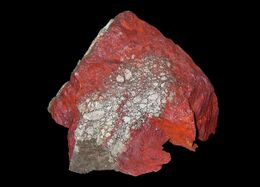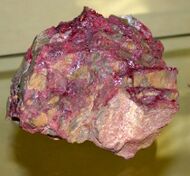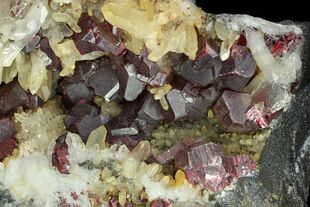Chemistry:Cinnabar
| Cinnabar | |
|---|---|
 | |
| General | |
| Category | Sulfide mineral |
| Formula (repeating unit) | Mercury(II) sulfide, HgS |
| Strunz classification | 2.CD.15a |
| Crystal system | Trigonal |
| Crystal class | Trapezohedral (32) (same H–M symbol) |
| Space group | P3121, P3221 |
| Unit cell | a = 4.145(2) Å, c = 9.496(2) Å, Z = 3 |
| Identification | |
| Color | Cochineal-red, towards brownish red and lead-gray |
| Crystal habit | Rhombohedral to tabular; granular to massive and as incrustations |
| Twinning | Simple contact twins, twin plane {0001} |
| Cleavage | Prismatic {1010}, perfect |
| Fracture | Uneven to subconchoidal |
| Tenacity | Slightly sectile |
| Mohs scale hardness | 2.0–2.5 |
| |re|er}} | Adamantine to dull |
| Streak | Scarlet |
| Diaphaneity | Transparent in thin pieces |
| Specific gravity | 8.176 |
| Optical properties | Uniaxial (+); very high relief |
| Refractive index | nω = 2.905 nε = 3.256 |
| Birefringence | δ = 0.351 |
| Solubility | 1.04×10−25 g/100 ml water (Ksp at 25 °C = 2×10−32)[1] |
| References | [2][3][4][5] |
Cinnabar (/ˈsɪnəˌbɑːr/; from grc κιννάβαρι (kinnábari)),[7] or cinnabarite (/ˌsɪnəˈbɑːraɪt/), is the bright scarlet to brick-red form of mercury(II) sulfide (HgS). It is the most common source ore for refining elemental mercury and is the historic source for the brilliant red or scarlet pigment termed vermilion and associated red mercury pigments.
Cinnabar generally occurs as a vein-filling mineral associated with volcanic activity and alkaline hot springs. The mineral resembles quartz in symmetry and it exhibits birefringence. Cinnabar has a mean refractive index near 3.2, a hardness between 2.0 and 2.5, and a specific gravity of approximately 8.1. The color and properties derive from a structure that is a hexagonal crystalline lattice belonging to the trigonal crystal system, crystals that sometimes exhibit twinning.
Cinnabar has been used for its color since antiquity in the Near East, including as a rouge-type cosmetic, in the New World since the Olmec culture, and in China since as early as the Yangshao culture, where it was used in coloring stoneware.
Associated modern precautions for the use and handling of cinnabar arise from the toxicity of the mercury component, which was recognized as early as ancient Rome.
Etymology
The name comes from Greek κιννάβαρι[7] (Script error: The function "transl" does not exist.),[8][9] a Greek word most likely applied by Theophrastus to several distinct substances.[7] In Latin, it was sometimes known as minium, meaning also "red cinnamon",[10] though both of these terms now refer specifically to lead tetroxide.[11]
Properties and structure
Properties
Cinnabar is generally found in a massive, granular, or earthy form and is bright scarlet to brick-red in color, though it occasionally occurs in crystals with a nonmetallic adamantine luster.[12][13] It resembles quartz in its symmetry. It exhibits birefringence, and it has the second-highest refractive index of any mineral.[14] Its mean refractive index is 3.08 (sodium light wavelengths),[15] versus the indices for diamond and the non-mineral gallium(III) arsenide (GaAs), which are 2.42 and 3.93, respectively. The hardness of cinnabar is 2.0–2.5 on the Mohs scale, and its specific gravity 8.1.[5]
Structure
Structurally, cinnabar belongs to the trigonal crystal system.[5] It occurs as thick tabular or slender prismatic crystals or as granular to massive incrustations.[3] Crystal twinning occurs as simple contact twins.[4]
Mercury(II) sulfide, HgS, adopts the cinnabar structure described, and one additional structure, i.e. it is dimorphous.[16] Cinnabar is the more stable form, and is a structure akin to that of HgO: each Hg center has two short Hg−S bonds (each 2.36 Å), and four longer Hg···S contacts (with 3.10, 3.10, 3.30 and 3.30 Å separations). In addition, HgS is found in a black, non-cinnabar polymorph (metacinnabar) that has the zincblende structure.[4]
Occurrence
Cinnabar generally occurs as a vein-filling mineral associated with volcanic activity and alkaline hot springs. Cinnabar is deposited by epithermal ascending aqueous solutions (those near the surface and not too hot) far removed from their igneous source.[17] It is associated with native mercury, stibnite, realgar, pyrite, marcasite, opal, quartz, chalcedony, dolomite, calcite, and barite.[3]
Cinnabar is essentially found in all mineral extraction localities that yield mercury, notably Almadén (Spain). This mine was exploited from Roman times until 1991, being for centuries the most important cinnabar deposit in the world. Good cinnabar crystals have also been found there.[18][19] Cinnabar deposits appear in Giza (Egypt); Puerto Princesa (Philippines); Red Devil, Alaska; Murfreesboro, Arkansas; New Almaden Mine[20][21] in San Jose, California; New Idria, California, the Hastings Mine and St. John's Mine both in Vallejo, California; Terlingua, Texas (United States); Idrija (Slovenia); Moschellandsberg near Obermoschel in the Palatinate; the La Ripa and Levigliani mines[22] at the foot of the Apuan Alps and in Mount Amiata (Tuscany, Italy); Avala (Serbia); Huancavelica (Peru); the province of Guizhou in China and Western ghats in India where fine crystals have been obtained. It has been found in Dominica near its sulfur springs at the southern end of the island along the west coast.[23]
Cinnabar is still being deposited, such as from the hot waters of Sulphur Bank Mine[24] in California and Steamboat Springs, Nevada (United States).[25]
Mining and extraction of mercury
File:Alchimia 1570 p 9.tif As the most common source of mercury in nature,[26] cinnabar has been mined for thousands of years, even as far back as the Neolithic Age.[27] During the Roman Empire it was mined both as a pigment,[28][29] and for its mercury content.[29]:XLI
To produce liquid mercury (quicksilver), crushed cinnabar ore is roasted in rotary furnaces. Pure mercury separates from sulfur in this process and easily evaporates. A condensing column is used to collect the liquid metal, which is most often shipped in iron flasks.[30]
Toxicity
Associated modern precautions for use and handling of cinnabar arise from the toxicity of the mercury component, which was recognized as early as in ancient Rome.[31] Because of its mercury content, cinnabar can be toxic to human beings. Overexposure to mercury, mercurialism, was seen as an occupational disease to the ancient Romans. Though people in ancient South America often used cinnabar for art, or processed it into refined mercury (as a means to gild silver and gold to objects), the toxic properties of mercury were well known. It was dangerous to those who mined and processed cinnabar; it caused shaking, loss of sense, and death. Data suggests that mercury was retorted from cinnabar and the workers were exposed to the toxic mercury fumes.[32] "Mining in the Spanish cinnabar mines of Almadén, 225 km (140 mi) southwest of Madrid, was regarded as being akin to a death sentence due to the shortened life expectancy of the miners, who were slaves or convicts."[33]
Decorative use
Cinnabar has been used for its color since antiquity in the Near East, including as a rouge-type cosmetic,[31] in the New World since the Olmec culture, and in China for writing on oracle bones as early as the Zhou dynasty. Late in the Song dynasty it was used in coloring lacquerware.[<span title="Lua error: not enough memory.">citation needed]Lua error: not enough memory.
Cinnabar's use as a color in the New World, since the Olmec culture,[34] is exemplified by its use in royal burial chambers during the peak of Maya civilization, most dramatically in the 7th-century tomb of the Red Queen in Palenque, where the remains of a noble woman and objects belonging to her in her sarcophagus were completely covered with bright red powder made from cinnabar.[35]
The most popularly known use of cinnabar is in Chinese carved lacquerware, a technique that apparently originated in the Song dynasty.[36] The danger of mercury poisoning may be reduced in ancient lacquerware by entraining the powdered pigment in lacquer,[37]Lua error: Internal error: The interpreter exited with status 1. but could still pose an environmental hazard if the pieces were accidentally destroyed. In the modern jewellery industry, the toxic pigment is replaced by a resin-based polymer that approximates the appearance of pigmented lacquer.Lua error: Internal error: The interpreter exited with status 1.
Two female mummies dated AD 1399 to 1475 found in Cerro Esmeralda in Chile in 1976 had clothes colored with cinnabar.[38]
Other forms
- Hepatic cinnabar, or paragite, is an impure brownish variety[39] from the mines of Idrija in the Carniola region of Slovenia, in which the cinnabar is mixed with bituminous and earthy matter.[40]
- Hypercinnabar crystallizes at high temperature in the hexagonal crystal system.[41]
- Metacinnabar is a black-colored form of mercury(II) sulfide, which crystallizes in the cubic crystal system.[42]
- Synthetic cinnabar is produced by treatment of mercury(II) salts with hydrogen sulfide to precipitate black, synthetic metacinnabar, which is then heated in water. This conversion is promoted by the presence of sodium sulfide.[43]
See also
- Vermilion
- Classification of minerals
- List of minerals
- Mercury cycle
- Red pigments
References
- ↑ Myers, R. J. (1986). "The new low value for the second dissociation constant of H2S. Its history, its best value, and its impact on teaching sulfide equilibria". Journal of Chemical Education 63: 689.
- ↑ "Cinnabar". https://www.mineralienatlas.de/lexikon/index.php/MineralData?mineral=Cinnabar.
- ↑ 3.0 3.1 3.2 "Cinnabar (HgS)". rruff.geo.arizona.edu. http://rruff.geo.arizona.edu/doclib/hom/cinnabar.pdf.
- ↑ 4.0 4.1 4.2 "Cinnabar: Cinnabar mineral information and data". Mindat. http://www.mindat.org/min-1052.html.
- ↑ 5.0 5.1 5.2 "Cinnabar Mineral Data". Webmineral. http://webmineral.com/data/Cinnabar.shtml.
- ↑ Warr, L.N. (2021). "IMA–CNMNC approved mineral symbols". Mineralogical Magazine 85 (3): 291–320. doi:10.1180/mgm.2021.43. Bibcode: 2021MinM...85..291W.
- ↑ 7.0 7.1 7.2 Cite error: Invalid
<ref>tag; no text was provided for refs namedEB1911 - ↑ Harper, Douglas. "cinnabar". Online Etymology Dictionary. https://www.etymonline.com/?term=cinnabar.
- ↑ Lua error: Internal error: The interpreter exited with status 1.. Liddell, Henry George; Scott, Robert; A Greek–English Lexicon at the Perseus Project.
- ↑ minium. Charlton T. Lewis and Charles Short. A Latin Dictionary on Perseus Project.
- ↑ Thompson, Daniel V. (1956). The Materials and Techniques of Medieval Painting. Chicago, IL: Dover (R. R. Donnelley-Courier). pp. 100–102.
- ↑ King, R. J. (2002). "Minerals Explained 37: Cinnabar". Geology Today 18 (5): 195–199. doi:10.1046/j.0266-6979.2003.00366.x.
- ↑ Klein, Cornelis; Hurlbut, Cornelius S. Jr (1985). Manual of Mineralogy (20th ed.). Wiley. p. 281. ISBN 0-471-80580-7. https://archive.org/details/manualofmineralo00klei.
- ↑ "Table of Refractive Indices and Double Refraction of Selected Gems - IGS" (in en). https://www.gemsociety.org/article/table-refractive-index-double-refraction-gems/.
- ↑ Schumann, W. (1997). Gemstones of the World. New York, NY: Sterling. ISBN 0-8069-9461-4. https://archive.org/details/gemstonesofworld00schu.Lua error: Internal error: The interpreter exited with status 1.
- ↑ Wells, A. F. (1984). Structural Inorganic Chemistry. Oxford, Oxon: Clarendon Press. ISBN 0-19-855370-6.Lua error: Internal error: The interpreter exited with status 1.
- ↑ White, Donald E. (1955). "Thermal Springs and Epithermal Ore Deposits". Fiftieth Anniversary Volume. 1905-1955. GeoScienceWorld. doi:10.5382/AV50.03. ISBN 978-1-9349-6952-6. https://pubs.geoscienceworld.org/segweb/books/book/1816/chapter/107705190/Thermal-Springs-and-Epithermal-Ore-Deposits.
- ↑ Calvo, Miguel (2003). Minerales y Minas de España. Vol. II. Sulfuros y sulfosales. Vitoria, Spain: Sulfuros y sulfosales. Museo de Ciencias Naturales de Alava. pp. 355–359. ISBN 84-7821-543-3.
- ↑ "Cinnabar. Spain". https://www.mindat.org/gm/1052?page=21.
- ↑ Santa Clara County Parks, Almaden Quicksilver Mining Museum https://parks.sccgov.org/plan-your-visit/activities/cultural-venues/almaden-quicksilver-mining-museum#1849274314-3146410750
- ↑ San Francisco Gate, "Tracking a toxic trail / Long-closed mine identified as largest source of mercury in San Francisco Bay" Dec 22, 2002 https://www.sfgate.com/bayarea/article/tracking-a-toxic-trail-long-closed-mine-2709557.php Accessed Sept. 10, 2023
- ↑ Dini, Andrea; Benvenuti, Marco; Costagliola, Pilar; Lattanzi, Pierfranco (2001). "Mercury deposits in metamorphic settings: the example of Levigliani and Ripa mines, Apuane Alps (Tuscany, Italy)". Ore Geology Reviews 18 (3): 149–167. doi:10.1016/S0169-1368(01)00026-9.
- ↑ Voudouris, Panagiotis; Kati, Marianna; Magganas, Andreas; Keith, Manuel; Valsami-Jones, Eugenia; Haase, Karsten; Klemd, Reiner; Nestmeyer, Mark (2020). "Arsenian Pyrite and Cinnabar from Active Submarine Nearshore Vents, Paleochori Bay, Milos Island, Greece". Minerals 11 (1): 14. doi:10.3390/min11010014. Bibcode: 2020Mine...11...14V. https://opus4.kobv.de/opus4-fau/files/15520/minerals-11-00014-v3.pdf.
- ↑ "Cinnabar from Sulphur Bank Mine (Sulfur Bank Mine; Sulphur Bank deposits), Clear Lake Oaks, Sulphur Creek Mining District (Sulfur Creek Mining District; Wilbur Springs Mining District), Lake Co., California, USA". Mindat. https://www.mindat.org/locentry-133387.html.
- ↑ "Cinnabar from Steamboat Springs mine, Steamboat Springs Mining District, Washoe Co., Nevada, USA". Mindat. https://www.mindat.org/locentry-204963.html.
- ↑ "Natural Sources: Mercury". Environment Canada. 9 January 2007. http://ec.gc.ca/mercure-mercury/default.asp?lang=En&n=2C1BBBDA-1.
- ↑ Martín Gil, J.; Martín Gil, F. J.; Delibes de Castro, G.; Zapatero Magdaleno, P.; Sarabia Herrero, F. J. (1995). "The first known use of vermillion". Experientia 51 (8): 759–761. doi:10.1007/BF01922425. ISSN 0014-4754. PMID 7649232.
- ↑ Vitruvius. De architectura. VII. 4–5.Lua error: Internal error: The interpreter exited with status 1.
- ↑ 29.0 29.1 Pliny. Natural History. XXXIII. 36–42.Lua error: Internal error: The interpreter exited with status 1.
- ↑ "Concentration of Isotopes of Mercury in Countercurrent Molecular Stills". Journal of Research of the National Bureau of Standards. https://nvlpubs.nist.gov/nistpubs/jres/041/jresv41n3p205_A1b.pdf.
- ↑ 31.0 31.1 Stewart, Susan (2014). "'Gleaming and deadly white': Toxic cosmetics in the Roman world". in Wexler, Philip. History of Toxicology and Environmental Health: Toxicology in Antiquity. II. New York, NY: Academic Press. p. 84. ISBN 978-0-12-801634-3. https://books.google.com/books?isbn=0128016345. Retrieved 2015-07-24.
- ↑ Petersen, G. (2010). Mining and Metallurgy in Ancient Peru. Special Paper 467. Boulder, CO: The Geological Society of America. p. 29. https://www.researchgate.net/publication/287174777.
- ↑ Hayes, A. W. (2014). Principles and Methods of Toxicology (6th ed.). New York, NY: Informa Healthcare. p. 10. ISBN 978-1-842-14537-1.
- ↑ "New World's Oldest". Time (magazine). 1957-07-29. http://www.time.com/time/magazine/article/0,9171,825208,00.html.
- ↑ Healy, Paul F.; Blainey, Marc G. (2011). "Ancient Maya mosaic mirrors: Function, symbolism, and meaning". Ancient Mesoamerica 22 (2): 230. doi:10.1017/S0956536111000241.
- ↑ Rawson, Jessica, ed (2007). The British Museum Book of Chinese Art (2nd ed.). British Museum Press. p. 178. ISBN 978-0-7141-2446-9.
- ↑ Dietrich, R. V. (2005). "Cinnabar". Gemrocks: Ornamental & Curio Stones. Ann Arbor, MI: University of Michigan. http://www.cst.cmich.edu/users/dietr1rv/cinnabar.htm.Lua error: Internal error: The interpreter exited with status 1.
- ↑ "Dressed to Kill: Chilean Mummies' Clothes Were Colored with Deadly Toxin". 27 July 2018. https://www.livescience.com/63181-mummies-poison-clothing.html.
- ↑ "Hepatic Cinnabar: Hepatic Cinnabar mineral information and data.". mindat.org. http://www.mindat.org/min-1871.html.
- ↑ Shepard, Charles Upham (1832). Treatise on Mineralogy. Hezekiah Howe. p. 132.
- ↑ "Hypercinnabar: Hypercinnabar mineral information and data.". Mindat. http://www.mindat.org/min-1994.html.
- ↑ "Metacinnabar: Metacinnabar mineral information and data.". Mindat. http://www.mindat.org/min-2670.html.
- ↑ Holleman, A. F.; Wiberg, E. (2001). Inorganic Chemistry. San Diego, CA: Academic Press. ISBN 0-12-352651-5.Lua error: Internal error: The interpreter exited with status 1.
Lua error: Internal error: The interpreter exited with status 1.
Further reading
- Stewart, Susan (2014). "'Gleaming and deadly white': Toxic cosmetics in the Roman world". in Wexler, Philip. History of Toxicology and Environmental Health: Toxicology in Antiquity. II. New York, NY: Academic Press. p. 84. ISBN 978-0-12-801634-3.
- Barone, G.; Di Bella, M.; Mastelloni, M. A.; Mazzoleni, P.; Quartieri, S.; Raneri, S.; Sabatino, G.; Vailati, C. (2016). "Pottery Production of the Pittore di Lipari: Chemical and Mineralogical Analysis of the Pigments". Minerals, Fluids and Rocks: Alphabet and Words of Planet Earth. Rimini: 2nd European Mineralogical Conference (EMC2016) 11–15 Sep 2016. p. 716.
External links
{{Navbox |name = Ores |title = Ore minerals, mineral mixtures and ore deposits |listclass = hlist
|group1 = Ores |list1 =
{{Navbox|subgroup
|groupwidth = 7.0em
|group1 = Oxides |list1 =
- Cassiterite (tin)
- Chromite (chromium)
- Coltan (niobium and tantalum)
- Columbite (niobium)
- Hematite (iron)
- Ilmenite (titanium)
- Magnetite (iron)}}
- Pyrolusite (manganese)
- Tantalite (tantalum)
- Uraninite (uranium)
Lua error: Internal error: The interpreter exited with status 1.




